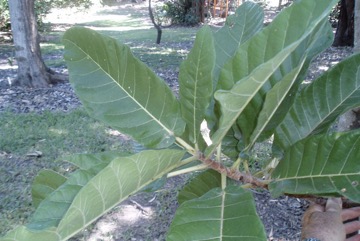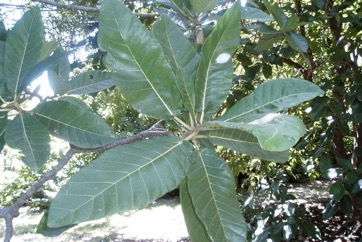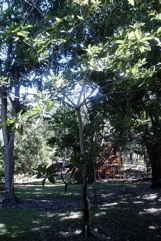Gutta perch tree

A tropical plant. It grows in dry savannah and wooded grassland. It grows in the Sahel. It grows between 950-1,200 m above sea level. It grows in areas with an annual rainfall between 600-1,300 mm. It can grow in arid places.
Also known as:
Bazlawar, Dundehi, Ebulai, Ebule, Gamji, Leiya, Liya, Mulombo, Ngabara, Oboloko, Pouhre, Rerumma, Surei, Titee
Synonyms
- Ficus umbrosa Warb.
- Ficus bibracteata Warb.
Edible Portion
- Fruit, Gum
Where does Gutta perch tree grow?
Found in: Africa, Burkina Faso, Cameroon, Central Africa, Côte d'Ivoire, East Africa, Egypt, Ethiopia, Gambia, Ghana, Guinea, Guinée, Guinea-Bissau, Ivory Coast, Mali, Mozambique, Niger, Nigeria, North Africa, Sahel, Senegal, Somalia, Southern Africa, South Sudan, Sudan, Uganda, West Africa, Zimbabwe
Notes: There are about 800-1000 Ficus species. They are mostly in the tropics. There are 120 Ficus species in tropical America.
Status: The fruit are usually eaten as a famine food.
Growing Gutta perch tree
Cultivation: Plants grow naturally from seed. Plants can also be grown from cuttings. The seed should be extracted from the figs and dried for planting. Seed can be stored fro 2 months.
Edible Uses: The fig fruit are eaten. The tree produces Niger Gutta which used to be used for chewing gum.
Nutrition Info
per 100g edible portion| Edible Part | Energy (kcal) | Protein (g) | Iron (mg) | Vitamin A (ug) | Vitamin c (mg) | Zinc (mg) | % Water |
|---|---|---|---|---|---|---|---|
| Fruit raw | 56 | 1.9 | 4 | - | - | - | 83 |
Gutta perch tree Photos



References
Abbiw, D.K., 1990, Useful Plants of Ghana. West African uses of wild and cultivated plants. Intermediate Technology Publications and the Royal Botanic Gardens, Kew. p 47
Abdel-Hameed, E. S., 2009, Total phenolic contents and free radical scavenging activity of certain Egyptian Ficus species leaf samples. Food Chemistry 114: 1271-1277
Addis, G., Asfaw, Z & Woldu, Z., 2013, Ethnobotany of Wild and Semi-wild Edible Plants of Konso Ethnic Community, South Ethiopia. Ethnobotany Research and Applications. 11:121-141
Addis, G., et al, 2013, The Role of Wild and Semi-wild Edible Plants in Household Food Sovereignty in Hamer and Konso Communities, South Ethiopia. Ethnobotany Research & Applications. 11:251-271
Burkill, H. M., 1985, The useful plants of west tropical Africa, Vol. 4. Kew.
Centurie de plantes d'Afrique 62. 1826 (F. Cailliaud, Voy. Meroe; 4:355. 1827)
Dalziel, J. M., 1937, The Useful plants of west tropical Africa. Crown Agents for the Colonies London.
FAO, 1988, Traditional Food Plants, FAO Food and Nutrition Paper 42. FAO Rome p 283
Food Composition Tables for use in Africa FAO http://www.fao.org/infoods/directory No. 915
Gallagher, D. E., 2010, Farming beyond the escarpment: Society, Environment, and Mobility in Precolonial Southeastern Burkina Faso. PhD University of Michigan.
Gilbert, T., et al, 2017, Diversity and local transformation of indigenous edible fruits in sahelian domain of Cameroon. Journal of Animal & Plant Sciences Vol. 26 (2): 5289-5300
Harris, F. M. A. and Salisu Mohammed, 2003, Relying on nature: Wild Foods in Northern Nigeria. AMBIO Vol. 32 No. 1, p 27
Jardin, C., 1970, List of Foods Used In Africa, FAO Nutrition Information Document Series No 2.p 137
Katende, A.B., Birnie, A & Tengnas B., 1995, Useful Trees and Shrubs for Uganda. Identification, Propagation and Management for Agricultural and Pastoral Communities. Technical handbook No 10. Regional Soil Conservation Unit, Nairobi, Kenya. p 320
Kidane, B., et al, 2014, Ethnobotany of Wild and Semi-wild Edible Fruit Species used by Maale and Ari Ethnic Communities in South Ethiopia. Ethnobotany Research and Applications. Vol. 12, 1546-3465-12-455
Le Houerou, H. N., (Ed.), 1980, Browse in Africa. The current state of knowledge. International Livestock Centre for Africa, Ethiopia. p 163
Lulekal, E., et al, 2011, Wild edible plants in Ethiopia: a review on their potential to combat food insecurity. Afrika Focus - Vol. 24, No 2. pp 71-121
Maydell, H. von, 1990, Trees and shrubs of the Sahel: their characteristics and uses. Margraf. p 279
MORTIMORE,
Ocho, D. L., et al, 2012, Assessing the levels of food shortage using the traffic light metaphor by analyzing the gathering and consumption of wild food plants, crop parts and crop residues in Konso, Ethiopia. Journal of Ethnobiology and Ethnomedicine 8:30
Ojelel, S. & Kakudidi, E. K., 2015, Wild edible plant species utilized by a subsistence farming community in the Obalanga sub-county, Amuria district, Uganda. Journal of Ethnobiology and Ethnomedicine. 11:7
Ojelel, S., et al, 2019, Wild edible plants used by communities in and around selected forest reserves of Teso-Karamoja region, Uganda. Journal of Ethnobiology and Ethnomedicine (2019) 15:3
Peters, C. R., O'Brien, E. M., and Drummond, R.B., 1992, Edible Wild plants of Sub-saharan Africa. Kew. p 150
Royal Botanic Gardens, Kew (1999). Survey of Economic Plants for Arid and Semi-Arid Lands (SEPASAL) database. Published on the Internet; http://www.rbgkew.org.uk/ceb/sepasal/internet [Accessed 4th May 2011]
Unwin, A. H., 1920, West African Forests and Forestry. Fisher Unwin Ltd. pdf on Internet p 107
Vivien, J., & Faure, J.J., 1996, Fruitiers Sauvages d'Afrique. Especes du Cameroun. CTA p 215
World Checklist of Useful Plant Species 2020. Royal Botanic Gardens, Kew
www.figweb.org